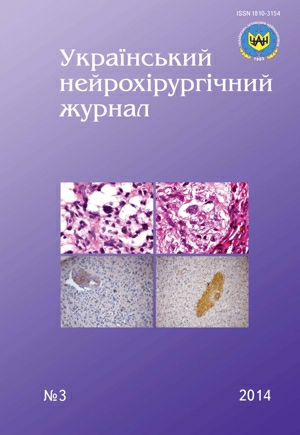Effectiveness of surgical and combined treatment of supratentorial primitive neuroectodermal tumors in children
DOI:
https://doi.org/10.25305/unj.47486Keywords:
brain tumors, primitive supratentorial neuroectodermal tumors, chemiotherapy, surgery, younger childrenAbstract
Introduction. The results of use of modern methods of treatment of malignant embryonic brain tumors — supratentorial primitive neuroectodermal tumors (sPNET) are given.
Materials and methods. The retrospective analysis of treatment results of 73 children with primitive brain sPNET in a period 1995–2011 was done. Combined methods of treatment were used — surgery, radiotherapy and chemotherapy.
Results. The study results demonstrate the need for aggressive therapy at such malignant tumors. After surgery death rate was 5.5%, survival rate in average — 31.2 months. Surgery radicalism, application of radiotherapy and chemotherapy affect the survival rate and quality of life of the patient.
Conclusion. Patients older than 3 years at whom according to treatment protocols at sPNEO radiotherapy can be used, as well as a comprehensive approach to treatment are positive predictors of survival and quality of life.
References
Enish V, Shrayber D, Gerlakh G. Opukholi tsentral'noy nervnoy sistemy u novorozhdennykh i grudnykh detey [CNS tumors in newborns and infants]. Arkh. patologii. 1984;7:19-26. Russian.
Zemskaia AG, Bersnev VP. [Congenital brain tumors in children under 1 year old]. Zh. Vopr.Neirokhir. Im. N.N. Burdenko. 19834:3-7. Russian. [PubMed]
Matsko DE, Korshunov AG. Atlas opukholey tsentral'noy nervnoy sistemy (gistologicheskoye stroyeniye) [Atlas of tumors of the central nervous system (histology)]. Sankt-Peterburg: RNSI; 1998. Russian.
Dirks PB, Harris L, Hoffman HJ, Humphreys RP, Drake JM, Rutka JT. Supratentorial primitive neuroectodermal tumors in children. J. Neurooncol. 1996;29(1):75-84. [PubMed]
Kaderali Z, Lamberti-Pasculli M, Rutka JT. The changing epidemiology of paediatric brain tumours: a review from the Hospital for Sick Children. Child’s Nerv. Syst. 2009; 25(7):787-793. [CrossRef] [PubMed]
Kuhl J, Doz F, Taylor RE. Embryonic tumors. In: Walker D, Perilongo G, Punt JAG, Taylor GE, editors. Brain and spinal tumors of childhood. London: Arnold; 2004. p.314-330, 436.
Louis D, Cavenee W, Ohgaki H. World Health Organization classification of tumors of the central nervous system. Lyon: Intern. Agency Res. Cancer, — 2007. 4th ed. p.8-11, 132-149.
Packer RJ. Progress and challenges in childhood brain tumors. J. Neuro-Oncol. 2005;75(3):239-242. [PubMed]
Raffel C, Rutka JT. Central nervous system primitive neuroectodermal tumors: still a useful classification? Neurosurg. Focus. 2011;30(1);Introduction. [CrossRef] [PubMed]
Sakar C, Deb P, Sharma MC. Recent advances in embryonal tumors of the central nervous system. Childs Nerv. Syst. 2005;21(2):227-293. [PubMed]
Korshunov AG, Smirnova AV, Gadzhieva OA. Embrional'nyye neyroektodermal'nyye opukholi bol'shikh polushariy golovnogo mozga [Embryonic neuroectodermal tumors of the cerebral hemispheres]. Arkh. patologii. 1995;1:44-51. Rusian.
Houdemont SP, De Carli E, Delion M, Ringuier B, Chapotte C, Jeudy C, Mercier P, Granry JC, Rialland X. Short-term neurological outcome of children after surgery for brain tumors: incidence and characteristics in a pediatric intensive care unit. Child’s Nerv. Syst. 2011;27(6):933-941. [CrossRef] [PubMed]
Johnston D, Daniel L, Keene L, Lafay-Cousin L, Steinbok P, Sung L, Carret AS, Crooks B, Strother D, Wilson B, Odame I, Eisenstat DD, Mpofu C, Zelcer S, Huang A, Bouffet E. Supratentorial primitive neuroectodermal tumors: a Canadian pediatric brain tumor consortium report. J. Neurooncol. 2008;86(1):101-108.
Reddy AT, Janss AJ, Phillips PS, Weiss HL, Packer RJ. Outcome for children with supratentorial primitive neuroectodermal tumors treated with surgery, radiation and chemotherapy. Cancer. 2000;88(9):2189-2193. [PubMed]
Hart MN, Earle KM. Primitive neuroectodermal tumors of the brain in children. Cancer. 1973;32(4):890-897. [PubMed]
Bleyer A, O’Leary M, Barr R, Ries LAG., editors. Cancer epidemiology in older adolescents and young adults 15 to 29 years of age, Including SEER Incidence and Survival: 1975–2000. Bethesda: National Cancer Institute; 2006. p.65-81.
Kadota RP, Allen JB, Hartman GA. Brain tumors in children. J. Pediatr. 1989;14(4):511-519. [PubMed]
Patel S, Bhatnagar A, Wear C, Osiro S, Gabriel A, Kimball D, John A, Fields PJ, Tubbs RS, Loukas M. Are pediatric brain tumors on the rise in the USA? Significant incidence and survival findings from the SEER database analysis. Child’s Nerv. Syst. 2014;30(1):147-154. [CrossRef] [PubMed]
Orlov YuA. Kachestvo zhizni detey, operirovannykh po povodu neyrokhirurgicheskoy patologii [The quality of life of children operated on for neurosurgical pathology]. Ukrainian Neurosurgical Journal. 2007;3:63-65. Russian.
Orlov YuА, Shaversky АV, Svyst АА, Mykhalyuk VS, Zyabchenko VI, Malysheva ТА, Chernenko ОG, Dovzhenko S.P Features of supratentorial primitive neuroectodermal tumors in young children. Ukrainian Neurosurgical Journal. 2012;4:46-49. Russian.
Orlov YuA, Shaversky АV, Zyabchenko VI. Supratentorial'nyye primitivnyye neyroektodermal'nyye opukholi u detey [Supratentorial primitive neuroectodermal tumors in children] [Internet]. Klin. Onkologia. 2012;7(3). Available at; http://www.clinicaloncology.com.ua/article/4863/supratentorialnye-primitivnye-nejroektodermalnye-opuxoli-u-detej
Downloads
Published
How to Cite
Issue
Section
License
Copyright (c) 2014 Yuriy Orlov, Andrii Shaverskyi, Vadym Ziabchenko, Tatyana Malysheva, Оksana Chernenko

This work is licensed under a Creative Commons Attribution 4.0 International License.
Ukrainian Neurosurgical Journal abides by the CREATIVE COMMONS copyright rights and permissions for open access journals.
Authors, who are published in this Journal, agree to the following conditions:
1. The authors reserve the right to authorship of the work and pass the first publication right of this work to the Journal under the terms of Creative Commons Attribution License, which allows others to freely distribute the published research with the obligatory reference to the authors of the original work and the first publication of the work in this Journal.
2. The authors have the right to conclude separate supplement agreements that relate to non-exclusive work distribution in the form of which it has been published by the Journal (for example, to upload the work to the online storage of the Journal or publish it as part of a monograph), provided that the reference to the first publication of the work in this Journal is included.









